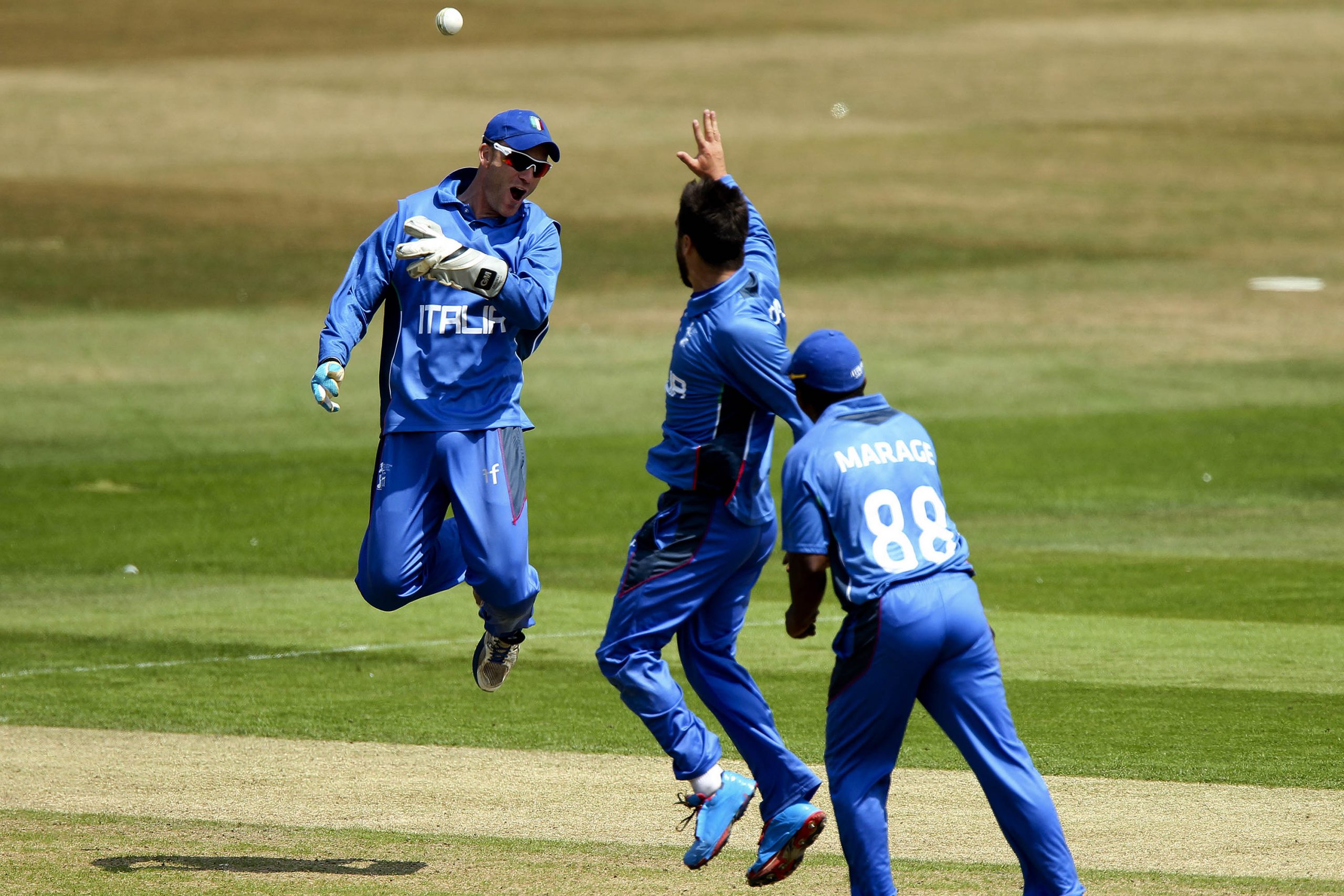The tough balancing act of Italian cricket
A diverse group of people, including a South Africa-born Brit and a Sri Lankan, are among those working to advance cricket as a sport in Italy. But there are plenty of sticky wickets in their path.
Author:
8 March 2021

“When I arrived in Italy, I never imagined I could play cricket,” says Francis Alphonsus Jayarajah, the Sri Lanka-born cricketer who went on to become Italy’s first Black national team captain. Jayarajah was part of the first Italian cricket team that took the field in 1984.
“I didn’t think cricket was played in Italy because football has always been in first place,” says Jayarajah. “In Sri Lanka, I was playing in college and thought I would quit once I left. Instead, I also found the opportunity here to express myself in cricket, a lifestyle that I was missing.”
Alfonso, as they call him in Italy, is a Christian of Tamil ethnicity who arrived in Rome in 1968 on an engineering scholarship from Opus Dei, an institution of the Catholic Church. Cricket was an unknown sport in the Italian capital at the time. It was viewed as something for Anglophone communities and institutions in the country.

The main theatre for the matches played in Rome was Villa Pamphilj, whose park Orietta Doria Pamphilj – the last heir of the ancient family from Rome – still owned. Part of the park was used as a cricket ground at the request of Wynn Hughes-Jones, one of the main architects of the United Kingdom’s entry into the European Economic Community who lived in Rome at the time, and as a result of the support of Frank Pogson, a retired Royal Navy admiral and Princess Orietta’s husband.
The initial edition of the Roma Ashes was held in 1962. It was the first form of organised cricket in Rome, through which personalities such as future archbishop of Cape Town, Owen Cardinal McCann, passed.
“The Commonwealth War Graves Commission team wanted me to join them and so my experience at Villa Pamphilj began,” says Jayarajah, who now serves as president of Roma Capannelle, the oldest active team in Italy, which he founded in 1978. Cricketers in Rome played at Villa Pamphilj until the state took over the park in 1972, forcing them to move to the Venerable English College pitch in Palazzola, where they played until 1980. But that pitch was too far away for the players and this had an impact on the growth, or lack thereof, of cricket.
But 1980 was an important year for the sport in the European country. Italian cricket board chief Simone Gambino describes it as “year zero of Italian cricket”. It’s the year in which the Italian Cricket Association was founded, with Gambino elected to be its first president. “In the beginning, there were only four teams. Anyone could play, but let’s say we started with the idea of giving more space to Italian players,” says Jayarajah.

Growing the sport
The goal was to make the sport popular among the wider population. For this reason, there were quotas in the early decades stating the mandatory number of Italians that had to be deployed on the field and the Italian Cup was created as a tournament open exclusively to Italian citizens.
The increase in migratory flows from Southeast Asia in the early 2000s triggered a new phase and had a huge impact on the make-up of the people who played cricket in Italy. The consequences of that decision are varied. On the one hand, the presence of Asian players or those of Asian descent has increased participation in the sport and led to a rise in the level of Italian cricket, which is still amateur. On the other hand, it has favoured the establishment of mono-ethnic clubs, such as Rome Bangla, Asian Latina and Jinnah Brescia, and slowed the development of talent from the wider population, with the risk of projecting cricket as a sport exclusively for Asians.
This convinced the federation – among the first in Italy – to adopt the sporting ius soli (citizen by birth) and open the doors of the national team to many.
This has put the federation in an awkward position as it attempts to balance the development of talent in the country with remaining open to migrants who improve the competitiveness of the sport. This is of particular concern in the senior national team, whose results are crucial to obtain greater political weight in the eyes of the international federation, and also where inclusivity is vital.
Related article:
To be more competitive, the Italian federation hired Northamptonshire allrounder Gareth Berg – who was born in South Africa, represented England and has Italian roots – as head coach of the national team. They also have a group who scout for Italian talent overseas. Stefano Pieri, another Italian-South African who took part in the pioneering years, scouts talent in South Africa. His job is to put the federation in contact with players of Italian descent who may be interested in representing the national team.
Italian-South African Manlio de Amicis, one of the members of the Italian Cricket Association’s first board, has the tough job of growing the sport among Italy’s youth, something he does not only because he has been assigned but because he is passionate about it. De Amicis fell in love with cricket while at Boksburg Central School in Gauteng. For him, “it is essential to consolidate the presence of cricket in schools in order to gain a grip on the younger segments of the Italian population”.
He has been training children in Roman schools since 1984. De Amicis estimates that he has brought hundreds of thousands of schoolchildren to his Lazio Cricket Club and encourages the enrolment of 20 boys on average annually.
The number of youth teams remains low, however, when compared to the 40 clubs affiliated with the federation. There are few youth sectors and only eight Under-13 teams. In some cases, the aggregative nature of the clubs doesn’t push them to focus on youth development. “In others, there is a lack of will,” says Leandro Jayarajah, the captain of Roma Capannelle and Alphonsus Jayarajah’s son. “They prefer to use resources to remain competitive at a senior level.”

Winning over new fans
A recent change by the federation – removing the obligation to create a youth sector in order to participate in the top league and replacing it with subsidies for clubs interested in doing so – seems to have improved the situation.
“Cricket will spread when the federation has the ability to fully present itself to the Italian population,” said Italian Cricket Federation general secretary Kelum Perera.
Cricket was formed in less frenetic societies than those in which we live, so much so that today a five-day Test match is difficult to digest for most Italians. For Perera, it is vital to adapt to the needs of today’s society. Bringing cricket closer to Italians, therefore, means making regulatory changes that reduce the duration of the matches and make them more appealing and attractive to the media. Promoting the Twenty20 format of the game is a move in this direction.

Offering cricket in schools helps reduce the cultural impact for people who don’t know the sport. For this reason, the federation has pushed to introduce cricket as one of the extracurricular activities schools in Italy can offer learners. But here another obstacle takes over: it is difficult to convince parents to take their children to play cricket in the absence of adequate infrastructure.
“We have made agreements with the Italian Sports Credit to finance the construction of new grounds,” says Perera, “and we have already reached a private one to build two cricket grounds inside the Novi Ligure racecourse.” The Institute for Sports Credit is the only public bank that supports sport and culture.
This would be added to those of Pianoro in Bologna, the first Italian cricket ground with a natural grass pitch, and Spinaceto in Rome, where the European Cricket Series was played. “We are also evaluating other areas and the overall investment will be around €2 million,” continues Perera.
Related article:
The Spinaceto ground, still under construction, is a project strongly desired by Lorena Haz and Prabath Ekneligoda, who head Roma Cricket Club. For them, investing in infrastructure is essential to convince families to let their children play cricket.
“Mothers worry if they have to take their children to the park to train. They wonder where they can shower,” said Haz and Ekneligoda. “When there are all the necessary services, it will be easier for Rome to involve schools and families, and it will be easier for us to invest in the youth sector, too.”
With cricket to be included in the 2028 Olympic Games, it will be easier to attract funding and improve the visibility of the game in Italy.
“I don’t think we would end up like curling, because cricket is played all year round and is practised by millions of people around the world,” says Perera. “Indeed, it would also help us to quantify the number of cricketers in Italy, which should be 70 000 to 80 000, and also attract those who still prefer to play informally, because we would play on beautiful grounds and offer a better product.”



